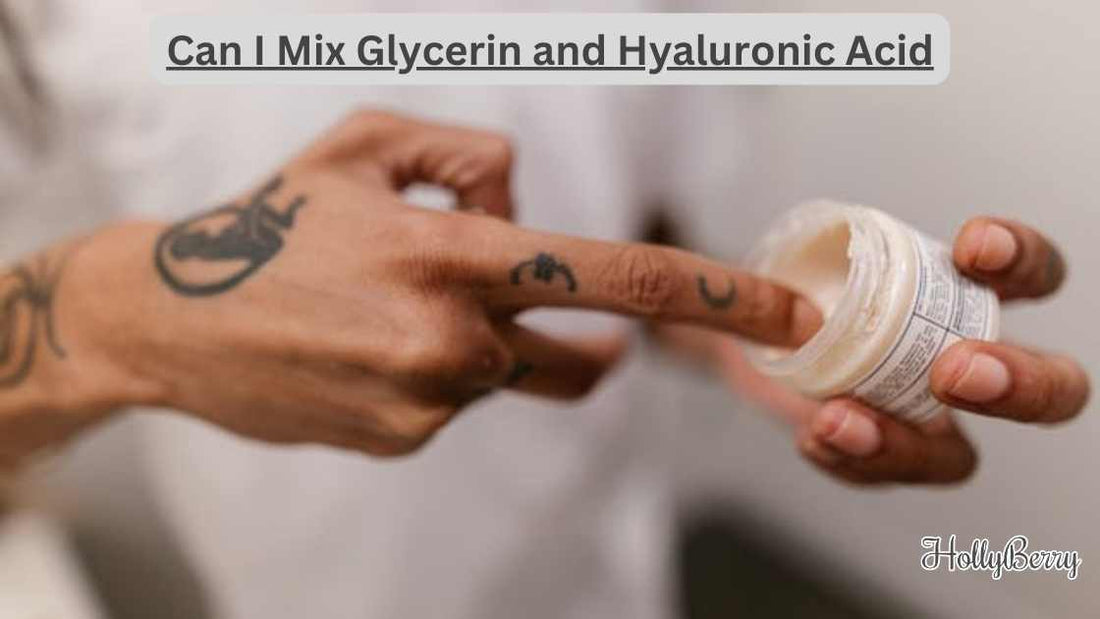
Can I Mix Glycerin and Hyaluronic Acid
Share
Expert Guidance and Tips

When it comes to skincare, hydration is key for maintaining a healthy and youthful appearance.
Two popular ingredients known for their moisturising properties are glycerin and hyaluronic acid. Both play an essential role in attracting and retaining moisture in the skin, making them ideal components in a variety of skincare products.
Glycerin, also known as glycerol, is a natural humectant derived from plants or animal fats. It works by drawing water from the deeper layers of the skin as well as from the air, ensuring the skin's surface remains moist and supple.
On the other hand, hyaluronic acid, a naturally occurring substance in the human body, is famous for its extraordinary water retention capabilities. It can hold up to 1,000 times its weight in water, providing instant hydration and plumping effects.
Many individuals interested in skincare wonder whether combining glycerin and hyaluronic acid in their routine can yield even better results.
In fact, it is possible and even beneficial to use both ingredients together, as they have complementary properties that can enhance the effectiveness of skincare products and ultimately support optimal skin hydration. For instance,
using a DIY Hyaluronic Acid Serum With Glycerin can provide an efficient and personalised solution for those looking to improve their skin's moisture balance.
Benefits and Effectiveness of Mixing Glycerin with Hyaluronic Acid
Hydration and Moisture Retention
Glycerin and Hyaluronic Acid are both humectants, which means they have the ability to attract and retain moisture in the skin.
Glycerin, a smaller molecule than hyaluronic acid, can penetrate deeper into the skin, drawing water up to just below the surface, making the skin appear plump and hydrated. In contrast, Hyaluronic Acid tends to hold moisture on the skin surface, forming a barrier to prevent water loss.
When mixed together, these two ingredients provide a powerful combination for hydration and moisture retention, making your skin feel nourished and refreshed.
Combating Wrinkles and Fine Lines
The powerful hydration provided by Glycerin and Hyaluronic Acid also holds the key to reducing the appearance of wrinkles and fine lines.
As the skin becomes more hydrated, it appears plumper and smoother, which in turn can minimise the visibility of wrinkles and fine lines.
This makes the combination of Glycerin and Hyaluronic Acid an excellent solution for those looking to maintain youthful-looking skin and slow down the signs of ageing.
Suitability for Different Skin Types
The beauty of mixing Glycerin with Hyaluronic Acid is that they are safe and effective for a wide range of skin types.
Sensitive skin may benefit from the gentle hydration provided by this combination, as Glycerin is known for its ability to strengthen the skin's moisture barrier and protect against irritants.
Dry skin can benefit from the deep hydration offered by Glycerin, while oily and acne-prone skin can also appreciate the lightweight moisture without causing excess oil production or clogged pores.
In summary, combining Glycerin with Hyaluronic Acid offers a highly effective and versatile solution to address various skin concerns.
With their excellent hydration, moisture retention, and suitability for different skin types, this combination provides numerous benefits for maintaining healthy, youthful, and radiant skin.
How to Mix and Apply Glycerin with Hyaluronic Acid
Preparing Your Own Serum
Creating a homemade serum using glycerin and hyaluronic acid is a simple process. Firstly, gather the required ingredients and equipment:
- Hyaluronic acid powder
- Glycerin
- Distilled water
- A small mixing bowl
- A whisk
- A glass dropper bottle or airtight container
Recipe and Instructions:
- In the small mixing bowl, add 1 teaspoon of hyaluronic acid powder.
- Add 1 teaspoon of glycerin and whisk together until the powder is fully dissolved.
- Slowly add 1 ounce (30ml) of distilled water while continuing to whisk until well combined.
- Carefully pour the serum into the glass dropper bottle or airtight container^[1^]. Let the serum sit for 1 hour to allow the hyaluronic acid to fully dissolve.
Incorporation into Skincare Routine

Order our Hyaluronic acid from our UK store with free shipping.
To incorporate the homemade glycerin and hyaluronic acid serum into your skincare routine, follow these steps:
- Begin with a clean face and neck area. Always cleanse your skin before applying any skincare products.
- Using the dropper, place a few drops of the serum onto your fingertips.
- Gently massage the serum onto your face and neck in an upward, circular motion. Do this until the serum is evenly distributed and absorbed into the skin.
- Allow the serum to dry for a couple of minutes, then proceed to apply other skincare products, such as your daily moisturisers.
- It's recommended to use the serum once or twice a day, depending upon your skin needs and personal preference.
Note: Hyaluronic acid helps prepping the skin to better receive the ingredients of the skincare products applied after it.
Potential Side Effects and Precautions
Hyaluronic acid and glycerin are generally well-tolerated by most skin types. However, it's essential to remain cautious when using new products.
Some potential side effects may include skin irritation or redness. To protect your skin, always perform a patch test before applying the serum to your entire face. If you experience any adverse reactions, discontinue use and consult a dermatologist if necessary.
For those with extra sensitive skin, consider using a diluted version of the serum by adding more distilled water. It's also important to use a gentle cleanser and moisturiser to ensure your skincare routine remains balanced and doesn't aggravate your skin.
In conclusion, mixing glycerin with hyaluronic acid is an effective way to create a hypermoisturising DIY serum. Incorporate it into your daily skincare routine to unlock the full benefits of these hydrating ingredients.
